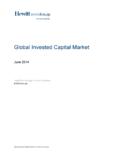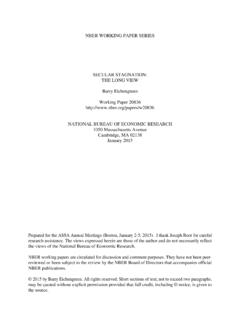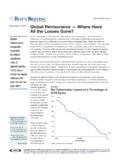Transcription of IPO insights - Comparing global stock exchanges - EY
1 !@#IPO insightsComparing global stock exchanges !@#1 Business operations and capital flows are becoming increasingly globalized as new centers of economic strength and innovation develop around the world. Future market-leading companies are springing up in such places as China, India, Korea and Eastern Europe, in addition to the mature economies of the US, Europe and Japan. While the majority of companies ultimately choose to list on their domestic stock exchanges , more and more business leaders today are considering the pros and cons of accessing public capital in a foreign exchanges are also working hard to take advantage of the global opportunities that arise in this environment whether by pursuing new listings from abroad or accessing foreign markets through mergers, acquisitions and strategic alliances. Business leaders today have many options to consider when selecting a stock exchange for an initial public report, a companion piece to Ernst & Young s global IPO Trends 2007 report, is designed to be an objective, fact-based comparative tool for business leaders weighing exchange alternatives.
2 The scope of this report encompasses the Australian Securities exchange , Deutsche B rse, Euronext, Hong Kong stock exchange , London stock exchange , NASDAQ, New York stock exchange , Singapore stock exchange and Tokyo stock exchange . Elements of this report include stock exchange strategic focus, a profile of the types of exchange -listed companies and IPO activity, listing standards and fees, the process and timeline of going public and the regulatory environment. Listing standards, fees and regulatory environment are perhaps the final factors to consider when selecting a stock exchange . However, as important, if not more so, are factors such as valuation, the quality of an exchange s institutional investors and their understanding of a company s business, the likelihood of attracting research coverage, visibility to customers and suppliers and comparable companies trading on the market.
3 If a company s selection of exchange does not have a clear connection to its business that makes sense to its investors, its valuation will likely be reduced. The selection of an exchange is a long-term strategic decision that should be determined primarily by a company s fundamental business drivers. While providing comparative stock exchange information, this report makes no evaluative conclusions about any of the exchanges in our study and provides no guidance about the eligibility of any company to list on any of the exchanges covered. The application of listing standards and fees and the IPO process are dependent on a company s specific situation. Admission to any exchange comes at the discretion of the stock exchange organization, and listing standards are subject to change. When evaluating a stock exchange , companies should consult with their business advisors and with the exchange organization Growth Markets Ernst & YoungIntroduction2 IPO insights : Comparing global stock exchanges1.
4 World stock exchange trends .. 4 Technology and globalization lead to greater competition among stock exchanges .. 4 Newly competitive stock exchanges demutualize, go public and consolidate .. 5 Demutualization and exchange consolidation are changing regulatory architecture.. 62. stock market strategic focus .. 8 Australian Securities exchange .. 8 Deutsche B rse (prime standard, general standard and entry standard).. 8 Euronext .. 10 Hong Kong stock exchange .. 10 London stock exchange .. 12 NASDAQ .. 12 New York stock exchange (NYSE Euronext) .. 14 Singapore stock exchange .. 14 Tokyo stock exchange .. 163. stock exchange profi les .. 18 Overview .. 18 Dominant share of global IPO transactions and capital raised.. 18 IPO transaction size .. 19 Number of listed companies.. 19 Market capitalization of listed companies .. 20 Top listed companies market capitalization.
5 20 Listed companies by industry.. 21 Listed companies by country of domicile .. 26 exchange IPO activity by industry .. 28 global initial public offerings by industry 2002 2006: exchange ranking .. 33 Initial public offerings by listing company country of domicile 2002 2006 .. 39 Notes on methodology .. 41 Contents34. stock market listing standards and fees .. 42 exchange listing standards.. 42 Income, revenue, and/or profi ts .. 42 Flotation and market capitalization .. 44 Operating history .. 45 Working capital and/or assets .. 46 Number of shareholders and/or share distribution .. 46 Requirements for foreign issuers .. 47 Foreign issuer requirements comparison.. 48 Lock-up requirements.. 50 exchange lock-up requirements .. 50 Equity market listing fees .. 51 Equity market listing fees by exchange .. 51 Assessment fees.. 53 Annual exchange fees .. 54 Comparison of annual exchange fees.
6 54 Cost of going public .. 565. Process and timetable of going public .. 58 Australian Securities exchange main market IPO process .. 58 Deutsche B rse IPO process.. 59 Euronext: Eurolist and Alternext IPO process .. 60 Hong Kong stock exchange main board IPO process . 62 London stock exchange : main market and AIM IPO process .. 63 Alternative investment market.. 64 NASDAQ and NYSE: the US IPO process .. 65 Singapore stock exchange main board IPO process .. 66 JASDAQ and TWE: the Japan IPO process .. 676. Regulatory environment .. 70 Regulatory environment .. 70 Corporate governance .. 70 Class action lawsuit considerations .. 77 Australia .. 77 France .. 77 Germany .. 77 Netherlands .. 77 Hong Kong .. 77 Japan .. 78 United Kingdom .. 78 United States .. 784 IPO insights : Comparing global stock exchangesThe world s major stock exchanges share a common challenge and opportunity: globalization.
7 Free-flowing capital , businesses without borders and new economic growth centers create an environment of intensified global competition among the world s stock exchanges . As a result of the growing competitive pressures, exchanges are actively seeking cross-border mergers, demutualizing and even going public while deploying new technology and service offerings all in an effort to win market share over their rivals. Today, world stock exchanges must vie for the most desirable and valuable new listings from abroad. More than ever, exchanges outside the main markets are proving capable of hosting large public offerings and many IPO-ready companies growing up outside the mature economies. Initial public offerings are the eagerly sought-after trophies in the contest between stock exchanges . Accustomed to conducting operations in multiple countries, many business leaders are becoming increasingly comfortable with listing outside their home markets.
8 A pre-listed company may select the exchange for its IPO based on numerous criteria, such as the exchange s prestige, its institutional investor base, listing costs, regulatory requirements, technology, stock market performance and the company s targeted markets. Although most companies still prefer to list on their home exchanges , many of today s global businesses are seeking the exchange that best suits their business plans, wherever it may be in the and globalization lead to greater competition among stock exchangesTechnology innovation has been a fundamental driver of stock exchange competition. As technological advances continue to make trading faster and cheaper and accessible from any place in the world, the local market dominance enjoyed by incumbent exchanges quickly erodes. Using price, execution speed or other advantages, an exchange can divert order flow from competitors.
9 For example, the London stock exchange (LSE) recently launched an electronic market called EuroSETS to capture order flow in Dutch stocks that would normally go to Euronext; Euronext s riposte was to begin trading FTSE-100 NASDAQ made a bid to increase its market share of New York stock exchange (NYSE)-listed stocks by significantly lowering routing fees late in pressures also come from non- exchange products and entities that provide technology-enabled alternatives to exchange -based trading. As potential alternatives to public listing, private equity and hedge funds provide access to growing pools of private growth capital . Automated trading systems (ATS), such as POSIT, Liquidnet and E-crossnet have also emerged to challenge exchanges . An ATS is a quasi- exchange where stocks are purchased and sold through a smaller, private network of brokers, dealers and other market participants (and not subject to the listing costs or price discovery processes on other exchanges ).
10 In 2006, a consortium of seven of the largest investment banks Citigroup, Credit Suisse, Deutsche Bank, Goldman Sachs, Merrill Lynch, Morgan Stanley and UBS announced a plan to set up a new pan-European equities trading platform called Project Turquoise. This new trading platform is intended to offer markedly lower costs than the existing exchanges and compete directly with the LSE and Euronext on price and speed. The goal is to drain the previous pricing power of dominant European exchanges and to pass savings on to the users of the platform. The globalization of capital markets and business operations is also playing an important role in exchange competition. In the last decade, global capital markets have experienced a sharp rise in cross-border flows of capital , ( , M&A activity, listings on foreign exchanges , global IPO activity) and have seen a dramatic increase in cross-border holdings of financial assets.















